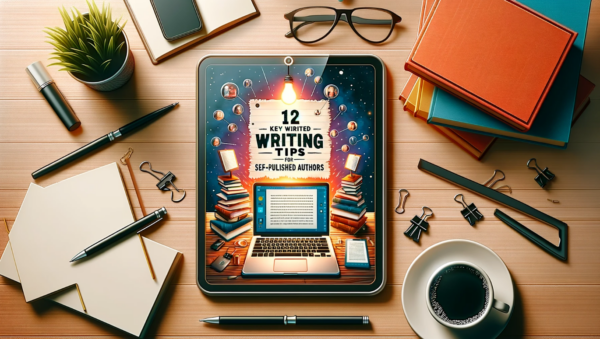Imagine opening a book and being immediately transported to a pivotal moment in the story’s universe, one that hints at the mysteries and adventures to come. This is the magic of a prologue. It serves as a curtain-raiser for your book, offering the reader a sneak peek into the world you’re about to unfold. It sets the tone, provides crucial background details, and often introduces key themes or characters.
Writing a prologue that effectively engages the reader is crucial; it’s the hook that captures their attention and compels them to keep turning the pages. In this article, we’ll explore the art of creative writing, focusing on crafting a compelling prologue that develops the plot and keeps readers engaged.
What Is a Prologue?
It is an introductory section of a literary work, distinct from the main story and often set apart by its unique purpose. Its primary role is to set the stage for the unfolding storyline to come, offering essential background information, context, or a glimpse of incidents that precede the plot.
In fiction, a prologue might introduce a crucial event or character backstory that influences the main storyline. In nonfiction, it can provide context or a compelling anecdote to pique interest. For example, readers looking for self-help or nonfiction books are often seeking information about topics like living in peace and harmony or cryogenics.
Your Publishing Journey Awaits – Start NowUnlike the first chapter, which usually dives directly into the story’s primary events, the prologue serves as a preparatory gateway, establishing the tone, setting, and key themes. A well-crafted prologue ensures that a reader is engaged and primed for the journey ahead.
The Importance of a Great Prologue
It is a powerful tool for capturing the reader’s interest from the very first page. It acts as a compelling hook, drawing readers into the story’s world with intrigue and excitement. By presenting an intriguing event, mysterious character, or tantalizing glimpse of the past, a prologue can create an immediate connection between the reader and the narrative.
Setting the tone is another crucial function of a prologue. It provides a taste of the story’s atmosphere, whether it’s dark and suspenseful, light and whimsical, or anything in between. This tonal foundation helps readers align their expectations and become immersed in the story’s mood right from the start.
Providing background info is essential, but it’s important to do so without falling into the trap of info dumping. This can be overwhelming—with excessive details, bogging down the storyline. Instead, a well-crafted prologue seamlessly weaves these details into the storyline, offering just enough to pique curiosity and build a foundation for understanding the main plot.
Key Elements of an Effective Prologue
Crafting an effective prologue involves blending several key components to create an engaging and informative opening for your story. Here are the essential elements:
Background: It should provide just enough background information to orient the reader without overwhelming them. These background details might include historical context, a brief overview of the setting, or important past events that influence the main story. The key is to sprinkle these details naturally, avoiding an info dump that can deter readers.
Important Events: Highlighting a crucial event in the prologue can serve as a powerful hook. This important event might be a turning point that sets the main story in motion or a dramatic incident that adds depth to the plot. It should be compelling enough to capture the reader’s attention and hint at the conflicts and challenges to come.
Establishing the Setting: Setting the scene is vital for immersing readers into your story’s world. Whether your tale unfolds in a fantastical realm, a bustling city, or a historical period, use vivid descriptions to paint a clear picture. This helps people to visualize the environment and sets the stage for the rest of the book.
Introducing Important Characters: The prologue is an excellent place to unveil key characters, especially the main character. Establishing the main character’s role and characteristics early on is crucial as it sets the tone and genre of the book. Provide insights into the main characters, their motivations, relationships, and conflicts to build a connection with the reader.
Setting Up the Story: The prologue should seamlessly lead into the main narrative, creating a bridge between the past and the present or between different narrative threads. It should raise questions and build anticipation, making readers eager to dive into the first chapter and discover how the story unfolds.
Differences Between a Prologue and First Chapter
While both the prologue and the first chapter are critical components of a novel, they serve distinct purposes in the storytelling process. A prologue acts as a prelude, providing readers with essential information, a glimpse into past incidents, or a setup for the story’s central conflict. Using a different style or perspective in the prologue can make the entire novel stand out, especially if it is not written from multiple points of view.
In contrast, the first chapter is where the main story truly begins. It introduces the primary plot, key characters, and immediate conflicts. This is where the reader meets the protagonist and gets a sense of the story’s direction and tone. The first chapter immerses the reader directly into the story, setting up the journey they will follow throughout the other chapters of the book.
In essence, the prologue sets the stage by laying down a foundation or teasing pivotal moments, while the first chapter dives into the actual story, engaging the reader with the unfolding action and character development. Together, these elements create a seamless transition from setup to storytelling.
5 Steps To Writing a Prologue
Writing a prologue can set the stage for an engaging story by capturing interest and setting the tone. Here’s a step-by-step guide to help you write an effective prologue.
Step 1: Determine the Purpose of the Prologue
Before you start writing, clarify why your story needs a prologue. Ask yourself what vital information or context you want to provide. A prologue should serve a specific purpose, such as introducing a key event, providing a background story, or setting the tone for the narrative. Knowing the purpose will guide your writing and ensure that it adds value to the story.
Step 2: Choose the Right Moment to Highlight
Select a moment that will captivate and offer essential insights into the story. When the prologue begins, it should set up high stakes and introduce the main conflict, creating anticipation and enhancing the captivating or thrilling nature of the subject matter. This could be a dramatic event, a pivotal character moment, or a crucial piece of history that sets up the main plot. The moment you choose should be intriguing enough to hook the reader’s interest and be relevant to the story’s central themes.
Step 3: Decide the Point of View and Narrative Style
Determine from whose perspective the prologue will be told and what narrative style you’ll use. Whether it’s first person, third person, or an omniscient narrator, choose a point of view that enhances the storytelling. The narrative style should align with the rest of the book while allowing the prologue to stand out as a unique piece.
Step 4: Keep It Concise and Engaging
A prologue should be concise, providing just enough information to intrigue and inform without overwhelming the reader. Aim for brevity and clarity, focusing on the most critical elements. Use vivid descriptions and dynamic language to draw readers in and maintain their interest. Avoid unnecessary details and keep the pacing tight to ensure the prologue is engaging.
Your Publishing Journey Awaits – Start NowStep 5: Ensure It Ties into the Main Story
The prologue should have a clear connection to the narrative, serving as a bridge between the introductory material and the story’s start. Make sure the events, characters, or themes introduced in the prologue are relevant and play a role in the unfolding plot. This connection will help readers understand the significance of the prologue and how it enhances the overall story.
Common Mistakes to Avoid
Writing a prologue can be tricky, and several common pitfalls can undermine its effectiveness. Here are some mistakes to watch out for and tips on how to avoid them:
Info Dumping
One of the most frequent errors is overwhelming the reader with too much information too soon. Info dumping can bog down the narrative and make the prologue feel more like a history lesson than an engaging start to a story. To avoid this, focus on providing only the most crucial background details. Sprinkle information throughout the prologue in a way that feels natural and keeps the reader engaged and intrigued.
Unnecessary Details
Another common mistake is including details that aren’t essential to the main plot. While it’s important to set the scene and provide context for other characters, filling the prologue with extraneous information can distract from the story and bore the reader. Stick to elements that directly impact the narrative and build anticipation for what’s to come.
Lack of Connection to the Main Narrative
A prologue that feels disconnected from the story can confuse readers and make them question its relevance. Ensure that the events or information presented in the prologue have a clear link to the plot. This connection can be thematic, character-based, or plot-driven, but it must be evident to the reader how the prologue enhances their understanding of the story.
Tips to Avoid These Mistakes:
1. Be Selective: Choose only the most important information and events to include in your prologue.
2. Stay Relevant: Ensure every detail you include serves a purpose and ties back to the main narrative.
3. Engage the Reader: Use vivid, dynamic language to keep the reader interested and excited about the story.
4. Revise and Edit: After writing your prologue, review it with a critical eye. Remove any elements that don’t contribute to the plot or slow down the pace.
By avoiding these common mistakes, you can create a prologue that is both informative and engaging, setting a strong foundation for your story.
The Role of the Prologue in Different Genres
The use of prologues can significantly differ across various genres, each utilizing this literary device to enhance the reader’s experience in unique ways. A prologue is different from the opening chapter of a novel or the start of a short story, as it contains the ‘juicy good stuff’ to hook prospective readers into fiction books.
Science Fiction
In sci-fi, prologues often introduce complex worlds, futuristic technologies, or pivotal events that shape the narrative’s setting. They can provide essential context about alien cultures, advanced scientific concepts, or dystopian societies. For example, the prologue of Frank Herbert’s Dune sets up the intricate political and ecological landscape of Arrakis, preparing readers for the epic saga that follows.
Mystery
Mystery novels frequently use prologues to present a crime or a mysterious event that kick-starts the plot. This initial glimpse creates suspense and curiosity, drawing readers into the puzzle-solving journey. Agatha Christie’s And Then There Were None uses a prologue to introduce the ten characters being invited to Soldier Island, hinting at the sinister events to come.
Historical Fiction
In historical fiction, prologues often provide historical context or introduce significant historical figures. They can transport people to a different era, setting the stage for the main story. A good example: Ken Follett’s The Pillars of the Earth opens with a few pages that depict a public hanging in 12th-century England, immediately immersing readers in the historical period and its harsh realities.
Fantasy
Fantasy prologues might delve into ancient myths, significant battles, or magical events that influence the story’s present. J.R.R. Tolkien’s The Lord of the Rings begins with a prologue that recounts key events in the history of the One Ring, establishing the central conflict and the lore of Middle-earth.
The Final Word: Crafting Prologues that Captivate
Mastering the art of writing a prologue can transform your story, making it irresistible to readers. We’ve delved into what makes it effective, its role across different genres, and the common pitfalls to avoid. A well-crafted prologue sets the tone, hooks the reader, and provides essential context, laying a solid foundation for your narrative. Remember, the prologue is your story’s first impression—make it count!
From Prologue to Epilogue your story deserves the best quality publishing platform there is. Using Spines can help you bring your story from past to present and every step along the way. Join us today to bring your story to life!
Interested in reading more…find out here if your young adult fiction needs a prologue!
Your Publishing Journey Awaits – Start Now






